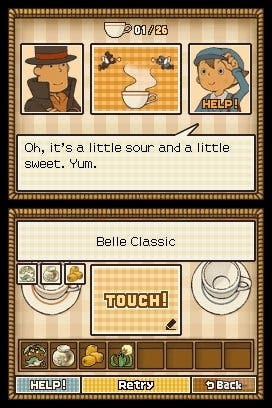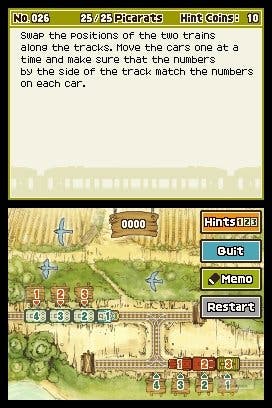Professor Layton and Pandora's Box
A truly gentlemanly experience.
This then gets more strange as the young girl from Curious Village, Flora, appears to join the Professor's entourage of kids. It reaches an unsettling zenith when you find what appears to be an adult theatre in the spooky city of Folsense, and a dubious woman starts making overtly flirtatious advances at Luke. Um. No thank you.
Of course, in the end a Professor Layton game will live or die by the power of its puzzles, whatever the reasoning behind their inclusion, and in this second part there are far more problems than the first. Curious Village had a couple that were slightly questionable in their logic; Pandora's Box has a few too many. Mostly this comes down to poor wording in the questions, where if you can work out in which of two or three possible directions the ambiguous prose was heading, you can manage to solve the puzzle. But sometimes this is only possible with trial and error. It's not common, but it's frustrating that it's there at all.
The puzzles themselves are a mix of maths, logic, sliding tiles and word games. There are dice, chess and peg puzzles that hark back to the classics, and an array of trick questions scattered throughout, more subtly than in the previous game. While most are elementary, quite a few are pretty tough. Anyone left thinking this is a children's game by the cartoon presentation should hear the adult language puzzle 118 caused me to produce.

A fantastic new inclusion that deals with a gripe from the original is the "memo" option when puzzle-solving. Previously only some puzzles would let you make scribbled notes on the screen - especially useful if you're being a smartypants and using algebra, but just as vital if you want to make a quick note, or cross out a known wrong answer. Now you hit "memo" and a translucent screen appears over the puzzle that can be written on. There's also smarter use of the stylus for many puzzles, letting you rearrange objects on the screen.
The accompanying mini-games are all completely new. Rather than a robot dog to build and eventually sniff out the hint coins that buy you clues for puzzles, this time you're given an overweight (and freakishly English-speaking) hamster to look after. Once you've completed a completely dreadful series of puzzles that cause him to lose weight (the whole thing seems like it was intended to be very clever, but can be completed with the minimum of skill), he will be your coin detector.
There's a camera to find parts of and build. Once completed it will let you take photographs of marked scenes, which then open up spot-the-difference puzzles, each of the three differences indicating the location of a bonus – generally two hint coins and one new bonus puzzle. These spot-the-differences are somewhat problematic, since the bordered version on the bottom screen shows less of the picture than the top screen. When scanning back and forth to spot differences, the pictures not including all the same items is damnably annoying.

Along with a diary to unlock with discovered keys, the final bonus inclusion is the daft-beyond-belief Tea Set. Here you are given a teapot, and a slowly growing number of ingredients from which to make new brews. Combining them is a hit-and-miss stumble toward finding consumable concoctions, which can then be served to other characters in the game when they display the lapse in fortitude that only a specific tea can help. Perhaps it's a Japanese joke spoofing the British – I'm not sure. But it's a lovely idea made slightly boring by the necessity to click through reams of repeated text as you brew the undrinkable.
Professor Layton and Pandora's Box is superbly charming (aside from its creepy moments), and Layton's constant reprimanding of Luke for not being gentlemanly enough is hilarious. A true gentleman always solves his puzzles, you know. But there's definitely a sense of slightly diminished returns in the puzzle selection. Creator Professor Akira Tago may be Mr Puzzle Pants, but you get the impression he used his very best ones in the first game, with a lot of repetition of ideas here. It's a small complaint that explains the small drop in score, but certainly doesn't prevent this from being an extremely enjoyable experience.








